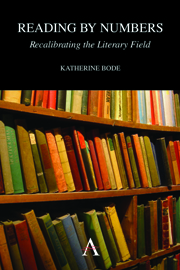Book contents
- Frontmatter
- Contents
- Acknowledgements
- List of Tables and Figures
- Introduction A New History of the Australian Novel
- Chapter 1 Literary Studies in the Digital Age
- Chapter 2 Beyond the Book: Publishing in the Nineteenth Century
- Chapter 3 Nostalgia and the Novel: Looking Back, Looking Forward
- Chapter 4 Recovering Gender: Rethinking the Nineteenth Century
- Chapter 5 The ‘Rise’ of the Woman Novelist: Popular and Literary Trends
- Conclusion Literary Studies in the Digital Future
- Notes
- Bibliography
- Index
Conclusion Literary Studies in the Digital Future
- Frontmatter
- Contents
- Acknowledgements
- List of Tables and Figures
- Introduction A New History of the Australian Novel
- Chapter 1 Literary Studies in the Digital Age
- Chapter 2 Beyond the Book: Publishing in the Nineteenth Century
- Chapter 3 Nostalgia and the Novel: Looking Back, Looking Forward
- Chapter 4 Recovering Gender: Rethinking the Nineteenth Century
- Chapter 5 The ‘Rise’ of the Woman Novelist: Popular and Literary Trends
- Conclusion Literary Studies in the Digital Future
- Notes
- Bibliography
- Index
Summary
The next big idea in language, history and the arts? Data.
This epigraph – from an article in the recent series by the New York Times, ‘Humanities 2.0’ – reflects growing interest in the way data and data-mining, and digital tools more broadly, are changing humanities scholarship. In ‘The Digital Future is Now: A Call to Action for the Humanities’, Christine Borgman similarly identifies ‘data- and informationintensive… research’ as a major future direction for the humanities. Just as the ‘availability of large volumes of data has enabled scientists to ask new questions in new ways’, she argues that increased existence and awareness of humanities data – largely in the form of cultural records and ‘especially as more records are digitised and made available to the public’ – will enable new approaches to, and perspectives on, research questions across the humanities. The editors of A Companion to the Digital Humanities agree, identifying data-mining as a common feature of the contributions to that collection, and a central component of future humanities research:
This method, or perhaps we should call it a heuristic, discovers a new horizon for humanities scholarship, a paradigm as powerful as any that has arisen in any humanities discipline in the past – and, indeed, maybe more powerful, because the rigor it requires will bring to our attention undocumented features of our own ideation.
Despite the prognostic tenor of such claims, quantitative and digital methods have a long history in the humanities.
- Type
- Chapter
- Information
- Reading by NumbersRecalibrating the Literary Field, pp. 169 - 174Publisher: Anthem PressPrint publication year: 2012

